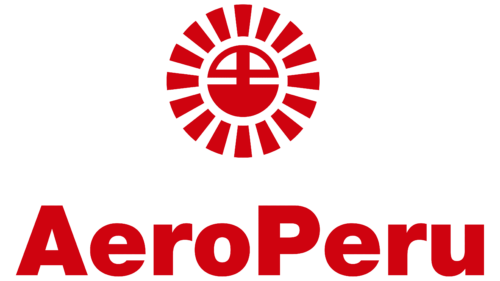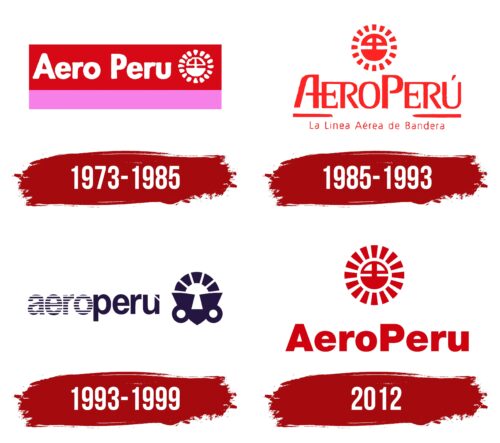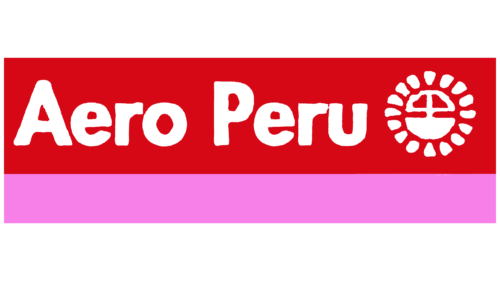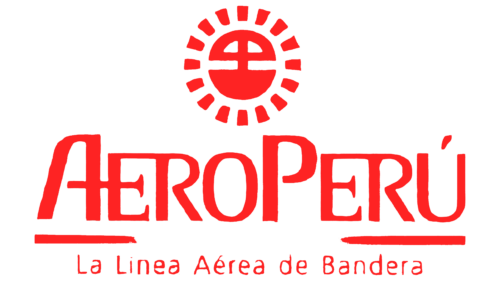The logo of AeroPeru, prominently featuring a stylized representation of the Nazca Lines, holds deep cultural significance. The Nazca Lines are ancient geoglyphs in Peru and one of the country’s most iconic and mysterious archaeological sites. These lines form various shapes that are only fully visible from the air, which is particularly fitting for an airline as it subtly celebrates the marvels of flight and the rich heritage of Peru. By incorporating this element, the logo connects AeroPeru to the modern act of flying and an ancient tradition that can be considered an early form of communication with the skies. The logo’s design bridges the past and present, symbolizing national pride and the airline’s role in showcasing Peru’s wonders.
Aeroperu: Brand overview
From 1973 to 1999, Aeroperú, Peru’s national airline, held a prominent position in the country’s aviation sector. Headquartered in Lima, the airline offers a wide range of domestic and international flights.
Established as a subsidiary of Aeroméxico, Aeroperú eventually became Peru’s flagship carrier. The airline had an extensive network covering more than 30 destinations in Peru and accessing various international routes throughout South America and the United States.
The airline’s main base was Jorge Chavez International Airport in Lima, with secondary hubs in Arequipa and Cusco. Aeroperú had a diverse fleet of Boeing and Airbus aircraft, including 727s, 737s, 757s, and A320s, to serve passengers.
At its peak in the 1990s, Aeroperú employed more than 3,000 people and had annual passenger traffic of over 4 million. However, the airline faced serious financial problems by the decade’s end and ceased operations in 1999.
A significant factor in the airline’s downfall was its involvement in several major accidents, including the tragic incident involving Flight 603 in 1996. Despite the sad end, Aeroperú significantly contributed to the Peruvian aviation industry over the years before declaring bankruptcy in the late 1990s.
Meaning and History
AeroPeru’s logos have always mirrored its identity and Peru’s rich culture. The early logos used symbols like a rising sun to show hope and new beginnings, tying into Peru’s past and the airline’s role. As the company changed, so did the logos, adopting a fresher look to match their modern approach to flying. The later logos, with bold reds and symbols that could remind one of the Nazca Lines, celebrated Peru’s history and the act of flying, all while keeping a strong sense of national pride. Even after AeroPeru stopped flying in 1999, its logos remain a powerful reminder of its time as Peru’s national airline and a key part of Peru’s aviation story.
What is Aeroperu?
Aeroperú, the national airline of Peru, was established in 1973 by merging two local carriers. It played a crucial role in the growth of Peruvian aviation for over 25 years, offering domestic and international flights. However, due to financial problems, an unsuccessful privatization attempt, and the tragic crash of Flight 603 in 1996, Aeroperú ceased operations and declared bankruptcy in 1999, leaving a significant mark on the country’s history.
1973 – 1985
Aeroperú’s first logo was simple yet meaningful from 1973 to 1985. It had two stripes: a pink one on the bottom and a red one on top. The pink represented the airline’s past, and the red looked forward to its bright future.
The name Aeroperú was in white, big, round letters, easy to see against the red. Next to the name was a red and white circle with rays that looked like a sunrise, a sign of hope and new beginnings. This circle also had a figure that could be seen as a boat, which ties back to the history of Europeans in Peru, or as a plane, showing what the airline does.
The red, white, and pink logo also nods to the Peruvian flag, showing that Aeroper was Peru’s main airline. Aeroperú’s logo honored Peru’s history while looking forward to its future in flying.
1985 – 1993
After Aeroperú was privatized, its logo changed to reflect better the airline’s focus on flying. The heavy borders were removed, making the logo lighter and giving it a sense of lift and freedom. This reflected the airline’s fresh start and goals.
The sun, which used to be in the middle of the old logo, was moved up, showing the airline’s aim to rise and succeed. The capital letters reaching up towards the sun symbolized growth. These changes made the logo look like it was pointing to a bright future for Aeroperú.
The two stripes in the logo hinted at the horizon and were split by the rising sun, showing a new beginning for the airline. The red color of the logo stood for speed, passion, and a warm welcome, all important for an airline that wanted to make a strong impression and move forward in the industry.
1993 – 1999
In 1993, Aeroperú tried to change its image with a new symbol and name style. But the new design was confusing. It had rectangles that were supposed to look like a sun rising, but people couldn’t tell what it was meant to be.
The bottom part was meant to show an airplane with engines, but it looked more like an old carriage than a modern plane. This mismatch made the logo seem old rather than new and advanced.
At the center was a shape like a keyhole, meant to show a view of far places and opportunities. However, this idea got lost because the remaining logo was unclear.
The logo used lowercase letters, which made the airline seem less important. It seemed to show that Aeroperú was less than Aeroméxico, not its strong brand. The letters’ Aero’ had stripes, and the ‘Perú’ was cut off at the corner, making the logo look uneven and poorly put together.
2012
For AeroPeru, the designers created a logo that embodies the country’s cultural heritage. The abstract symbol features two semicircles, one hollow and one filled, connected by a vertical rectangle and enclosed in a ring of sixteen suns. Below this, the airline’s name appears in a straight sans-serif font. Both the bold letters and the geometric pattern are colored in a rich dark red, reflecting the flag of Peru.
Using sixteen suns and geometric shapes reflects Peru’s various cultural and historical elements, possibly referring to Inca or pre-Inca symbolism. The rich dark red color unifies the design, symbolizing national pride and identity, as seen in the Peruvian flag. The simple sans-serif font for the company name ensures clear readability while allowing the intricate emblem to stand out.
This AeroPeru logo showcases the country’s cultural essence. The abstract symbol includes two semicircles, one hollow and one filled, connected by a vertical rectangle and surrounded by a ring of sixteen suns. The airline’s name is displayed below in a straightforward sans-serif font. The bold letters and geometric design share a rich dark red hue, paying homage to the Peruvian flag.
Incorporating sixteen suns and geometric shapes into the logo reflects Peru’s rich cultural and historical heritage, potentially alluding to Inca or pre-Inca symbols. The dark red color ties the design together, representing national pride and identity, mirroring the colors of the Peruvian flag. The sans-serif font used for the company name maintains legibility and complements the complex emblem.
Font and Colors
The logo uses a bold, sans-serif font that is clear and easy to read. The lettering is in uppercase, which adds to the logo’s prominence and authority. The font’s size is large, ensuring that the brand name ‘AeroPeru’ is visible and stands out, making it memorable.
The logo employs a vibrant, eye-catching, and energetic red. This color choice is likely intended to grab attention and convey a sense of excitement and dynamism, which fits with the nature of an airline company. The red used here also has cultural significance, possibly relating to the colors of the Peruvian flag, thereby reinforcing national identity.
FAQ
Does Aeroperu still exist?
Aeroperú was the main airline of Peru, starting in 1973. It was important for flights within Peru and to other countries. But in 1999, it had to stop its operations. This was because it faced money problems, issues with management, and tough economic times in Peru during the 1990s. Also, more competition from other airlines made things harder for Aeroperú.
After Aeroperú stopped, no other airline took its place or brought back its name. Other airlines eventually took over the routes Aeroperú used to fly. Today, many airlines operate in Peru, serving local and international destinations. The story of Aeroperú is still an important part of Peru’s aviation history, showing the industry’s ups and downs back then.
What is the flag carrier airline of Peru?
LATAM Airlines Peru is Peru’s main airline, previously known as LAN Perú. It’s part of the larger LATAM Airlines Group and is Peru’s national airline. It operates from Jorge Chávez International Airport in Lima, connecting Peru to many places worldwide.
This airline started after Peru opened its airline market, taking over from Aeroperú. It has become a major player in the region, using Lima’s location to connect flights between North and South America and Europe, the Caribbean, and other places.
Joining the LATAM Airlines Group, which combines LAN Airlines from Chile and TAM Airlines from Brazil, has strengthened it. This merger offers more destinations and better connectivity, helping LATAM Airlines Peru boost tourism and the economy in Peru.
Why did Aeroperu crash?
The Aeroperú Flight 603 crash in 1996 was a tragic accident caused by several problems that made the plane crash into the Pacific Ocean. The main issue was that the flight crew didn’t properly handle many wrong warnings.
When the plane came down through 2,500 feet (about 760 meters), the crew was too distracted by these wrong alerts to notice what the radar altimeter was saying. This tool was working right, telling them how high they were above the sea or ground.
The wrong signals started because the tape was left over some sensors from maintenance work, messing up the plane’s speed and height readings. With these key details wrong, the pilots were flying blind, not having the right data for a safe flight. Despite all the confusing alarms, they missed the accurate info from the radar altimeter, leading to a grave mistake about where the plane was.








